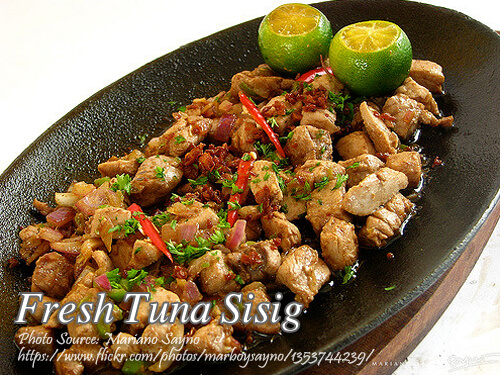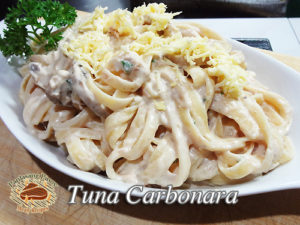This tuna sisig is the fish version of your favorite pork sisig. It is made from fresh tuna fillet cubes and marinated with liquid seasoning then fried until crispy. But you also fry them until brown if you want it meaty and still have some juices in it. I think you can also use canned tuna chunks but the taste is not as good as the fresh tuna. If you are abstaining from pork, this is a good version of sisig to try. Try it and you’ll love it!
Fresh Tuna Sisig: A Lighter Twist on a Filipino Classic
Every Filipino kitchen has its own take on sisig, a dish that’s earned its place as a beloved classic in countless homes. Traditionally made with crispy bits of pork, sisig has been reimagined in creative ways over the years. My personal favorite? Fresh tuna sisig. This fish-based version delivers all the bold, savory flavors we love but with a lighter and healthier twist.
The inspiration to try this came from my Uncle Ruben, who has been a fisherman in Zambales for as long as I can remember. One summer, during a family reunion at their beachside home, he surprised us by serving a sizzling plate of sisig that wasn’t the usual pork. Instead, it was made with freshly caught tuna from the local waters. At first, I was skeptical, but after one bite, I was hooked.
Why Fresh Tuna Makes All the Difference
Using fresh tuna fillet cubes is the secret to achieving that satisfying balance of texture and flavor. Unlike canned tuna, which can sometimes taste flat or overly processed, fresh tuna brings a clean, meaty richness to the dish. When fried until golden brown and crispy, the tuna develops a satisfying crunch on the outside while remaining tender inside.
Uncle Ruben swears by marinating the fish in liquid seasoning and calamansi juice before frying. This simple step not only infuses the tuna with bright, tangy flavors but also helps lock in moisture, keeping it juicy even after cooking.
Cooking Techniques That Elevate Your Tuna Sisig
The magic of this dish lies in the cooking techniques, and they’re beginner-friendly! Start by marinating the tuna for at least 15 minutes. This step is crucial because it gives the fish a chance to absorb all the delicious flavors of the seasoning. Calamansi juice, a staple in Filipino cooking, adds that signature citrusy zing that balances the richness of the fried tuna.
Frying the tuna until crispy creates a delightful texture that contrasts beautifully with the soft, caramelized onions. When you fry, make sure to use medium heat to avoid burning the fish. If you prefer a meatier texture, you can fry it until just lightly browned to retain more of the natural juices.
Once the tuna is cooked, the next step is to sauté onions in a bit of oil. Don’t skip this part—it’s what brings out the natural sweetness of the onions, adding depth to the dish. Stir in the fried tuna, season with more liquid seasoning and a pinch of granulated seasoning, and let the flavors meld together.
Bringing It All Together on a Sizzling Plate
If you’ve ever had sisig served at a restaurant, you know the thrill of hearing that sizzle as the dish is brought to your table. Recreating that experience at home is easier than you think. Simply transfer your tuna sisig onto a heated and buttered sizzling plate. The butter adds a layer of richness and helps prevent the fish from sticking.
For a final touch, sprinkle crushed chicharon on top. It’s optional, but trust me, the added crunch takes the dish to the next level. My cousin Maribel loves to add a dollop of mayonnaise for creaminess, and my brother Jason likes to top his with fresh chilies for extra heat. These little tweaks make the dish even more customizable to your taste.
A Brief History of Sisig
Did you know that sisig originated in Pampanga, the culinary capital of the Philippines? The word “sisig” comes from an old Kapampangan term meaning “to snack on something sour.” Originally, it referred to unripe fruits dipped in vinegar or salt, but over time, it evolved into the sizzling dish we know today. While pork sisig remains the most popular version, variations like tuna sisig showcase the versatility of this iconic dish.
Why You’ll Love Tuna Sisig
Tuna sisig isn’t just a healthier alternative to its pork counterpart; it’s also packed with bold, umami-rich flavors that are guaranteed to impress. Whether you’re serving it as an appetizer, pulutan, or even as a main dish with steamed rice, this recipe is a crowd-pleaser.
For me, every bite brings back fond memories of summers spent by the sea, surrounded by family and the comforting aroma of sizzling dishes. It’s more than just food—it’s a reminder of home, tradition, and the simple joys of sharing a meal with loved ones.
So the next time you’re craving something hearty yet light, give this sisig a try. Who knows? It might just become your new favorite, too!
How to Cook Fresh Tuna Sisig
Ingredients
- 1/2 kilo tuna fish fillet cubed
- 1/4 cup liquid seasoning with calamansi
- cooking oil for frying
- 2 tablespoons cooking oil
- 1/2 cup onions chopped
- 1 tsp granulated seasoning e.g. Magic Sarap
- 1 tablespoon liquid seasoning
- crushed pork chicharon pork rind cracklings, optional
Instructions
How to cook Fresh Tuna Sisig:
- Marinate tuna in liquid seasoning with calamansi for at least 15 minutes.
- Fry marinated tuna until brown and crispy. Set aside.
- Heat oil and saute onions for 30 seconds. Stir in prepared tuna and season with granulated seasoning and liquid seasoning.
- Transfer on a heated and buttered sizzling plate. Top with crushed chicharon if desired.
Note:
- Preparation Time 10 minutes plus 15 minutes to marinate tuna. Cooking time is 20 minutes.
Notes
Cooking Tips:
Marinate for Maximum Flavor
Marinating the fresh tuna in liquid seasoning and calamansi juice for at least 15 minutes ensures every cube is packed with bold, tangy flavors. This step not only infuses the fish with zest but also helps retain its moisture during frying. Don’t rush this process; a good marinade is the key to a flavorful and juicy tuna sisig.Fry with the Right Technique
Fry the marinated tuna in medium heat to achieve a golden-brown, crispy exterior without overcooking the inside. Avoid overcrowding the pan, as this can lower the temperature and prevent the tuna from crisping up properly. For a softer, juicier texture, stop frying once the edges turn light brown rather than fully crispy.Don’t Skip the Sizzling Plate
A heated and buttered sizzling plate isn’t just for presentation—it adds richness and keeps the sisig hot while you serve. The butter also enhances the aroma and prevents the tuna from sticking to the plate. If you don’t have a sizzling plate, serve the dish in a pre-warmed dish to retain its heat and appeal.






Love your tuna sisig. Very simple and easy to cook! Thanks!
Hi Bitoy! You are welcome!